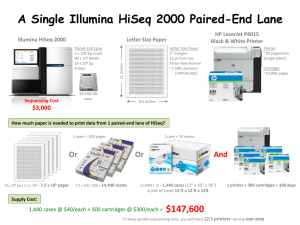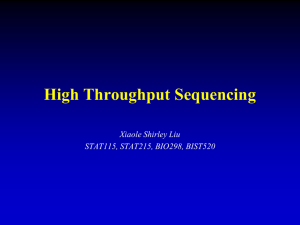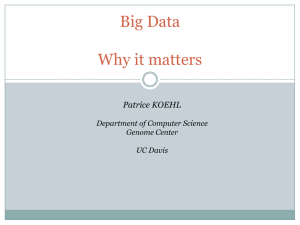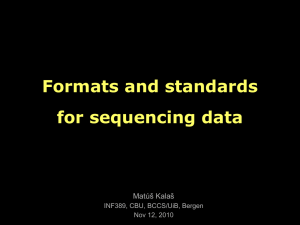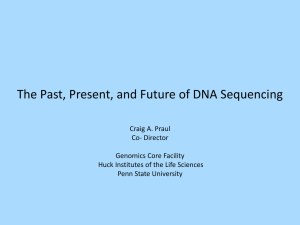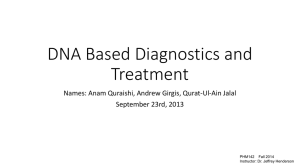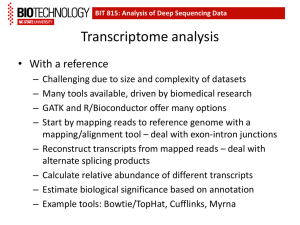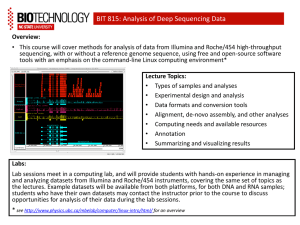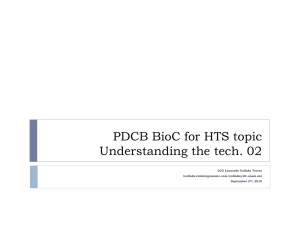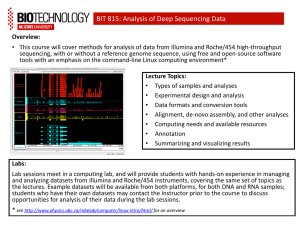1 - Laboratory of Computational and Quantitative Biology
advertisement
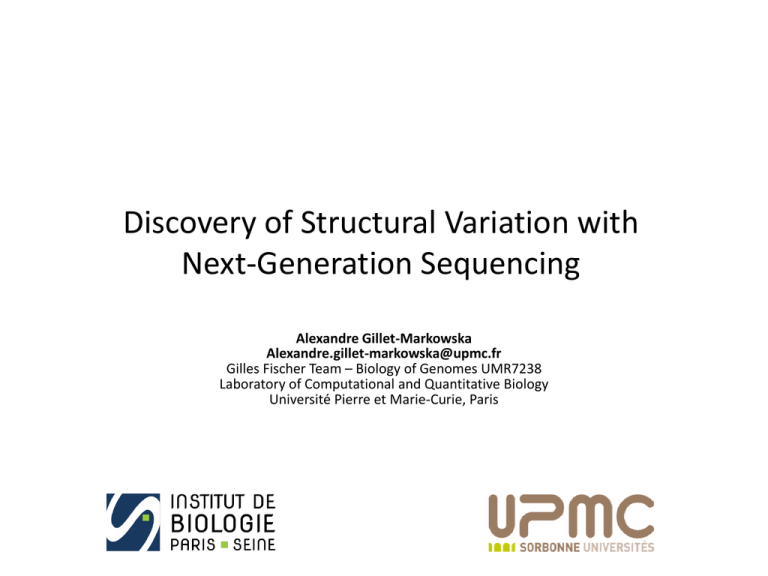
Discovery of Structural Variation with Next-Generation Sequencing Alexandre Gillet-Markowska Alexandre.gillet-markowska@upmc.fr Gilles Fischer Team – Biology of Genomes UMR7238 Laboratory of Computational and Quantitative Biology Université Pierre et Marie-Curie, Paris outline (i) Structural variations (SV) (ii) SV detection technologies (iii) Read pairs: 2 types of Illumina genomic DNA libraries (iv) SV detection using Read pairs (v) Polymorphic SV Structural Variations (SV) Structural Variations (SV) 1 1Yes, the minimal size is arbitrary… Structural Variations (SV) Structural Variations (SV) Structural Variations (SV) Structural Variations (SV) Balanced SV versus Unbalanced SV Intrachromosomal SV Interchromosomal SV Unbalanced SV (CNV) Balanced SV INVERSION (INV) RECIPROCAL TRANSLOCATION (RT) ref ref SV SV DELETION (DEL) TANDEM DUPLICATION (DUP) INSERTION (INS) ref ref SV SV Pictures adapted from Feuk et al., 2006 Nature Reviews Calvin Blackman Bridges, Science Why Discover SV ? involved in > 30 diseases (Psoriasis, Crohn disease, ASD…) chromosomal instability detected in the vast majority of cancers powerful mechanism of adaptation and evolution SV detection technologies Timeline of technologies used to discover SV SV, Structural Variations since 1936 Calvin Blackman Bridges, Science Lejeune, Study of somatic chromosomes from 9 mongoloid children, Hebd Seances Acad Sci Smith et al, Interstitial deletion of (17)(p11.2p11.2) in nine patients. Am J Med Genet 1936 1959 1986 Comparative cytogenetics Timeline of technologies used to discover SV SV, Structural Variations since 1936 Calvin Blackman Bridges, Science Lejeune, Study of somatic chromosomes from 9 mongoloid children, Hebd Seances Acad Sci Smith et al, Interstitial deletion of (17)(p11.2p11.2) in nine patients. Am J Med Genet Sebat, Large-scale copy number polymorphism in the human genome, Science Iafrate, Detection of large-scale variation in the human genome, Nature 1936 1959 1986 2004 Microarrays 200 et 221 CNV Redon, Global variation in copy number in the human genome, Nature 360 Mb CNVR (12% du génome humain) Comparative cytogenetics 2006 Timeline of technologies used to discover SV SV, Structural Variations since 1936 Calvin Blackman Bridges, Science Lejeune, Study of somatic chromosomes from 9 mongoloid children, Hebd Seances Acad Sci Smith et al, Interstitial deletion of (17)(p11.2p11.2) in nine patients. Am J Med Genet Sebat, Large-scale copy number polymorphism in the human genome, Science Iafrate, Detection of large-scale variation in the human genome, Nature 1936 1959 1986 2004 Microarrays 200 et 221 CNV Redon, Global variation in copy number in the human genome, Nature 360 Mb CNVR (12% du génome humain) Korbel et al, Paired-end mapping reveals extensive structural variation in the human genome, Science 2006 2007 NGS 1 000 SV 1000 HGP, A map of human genome variation from population-scale sequencing, Nature 20 000 SV Comparative cytogenetics 2010 ‘Range of usability’ of technologies Size limit SV type limit SV detection with NGS data How to detect SV with NGS data ? Quinlan & Hall 2011 Trends in Genetics Breakpoints res. 1-10 bp 1 bp 1 bp >100 bp SV size range >10 bp 1 bp–50 kbp >1 bp > Insert Size CNV Yes Yes Yes Yes Balanced SV No Yes Yes Yes FDR High? >10% low Variable Missing rate High? >25% High? Variable LI 2011 Nature Read pairs: 2 types of Illumina genomic DNA libraries 1) Illumina Paired-End 2) Illumina Mate-Pair 1) Illumina Paired-End 2) Illumina Mate-Pair Illumina Paired end vs Mate-Pair (MP allows a better genome assembly than PE) MP allows to detect SV that involve repeated elements Illumina Paired end vs Mate-Pair (or much less…) Insert-size distribution of 100,000 read-pairs Insert-size (bp) 5,000 Illumina Paired end vs Mate-Pair SV detection with Read pairs 1) 2) 3) 4) trim the data align data to reference genome remove PCR duplicates SV calling Trim the data First criteria: Chargaff rule Trim the data First criteria : %A = %T and %G = %C on both DNA strands Trim the data Second criteria: nucleotide quality Trimming tools Bcbio-nextgen Btrim CANGS Chipster Clean reads ConDeTri Ea-utils Fastx Flexbar PRINSEQ Reaper SeqTrim Skewer SolexaQA TagCleaner Trimmomatic Align the data to reference genome Remove PCR duplicates PCR duplicates annotation tools samtools rmdup (only intra-molecular duplicates) markduplicates.jar (picard tools) FastUniq … SV signatures SV have nearly identical signatures with MP and PE SV signatures Gillet-Markowska, 2014, Bioinformatics SV signatures SV signatures Inter-tool variability is immense Inter-tool variability is immense Inter-tool variability is immense Adapted from ICGC-TCGA challenge Inter-tool variability is immense SV examples SV in the Human genome Korbel et al, Science 2007 Not-so-identical monozygotic twins Bruder, C. E. G. et al. Phenotypically concordant and discordant monozygotic twins display different DNA copy-number-variation profiles. Am. J. Hum. Genet. 82, 763–771 (2008) Butterfly mimicry Butterfly mimicry Livestock phenotypes caused by CNV Polymorphic SV Structural Variations (SV) Polymorphic SV Structural Variations (SV) Individual (germ line) SV in 100% of cells of each individual Tissue (somatic) SV in one tissue / in a few cells Sequencing a single culture (n=80) DNA extraction Sequencing S. cerevisiae DNA extraction Sequencing #cells 124 109 Bottleneck 1 #generation 0 Bottleneck 2 30 Bottleneck 3 60 90 Bottleneck 4 Bottleneck 5 120 150 Bottleneck 80 2400 Can we detect de novo SV occurring in a single cell culture by high throughput sequencing ? # generations # cells 0 1 1 2 2 4 11 12 13 14 103 2.103 8.103 1.6.104 700X 30 109 6,000X The physical coverage (theoretically) sets the detection threshold Sequencing with high physical coverage Pair-End sequencing: insert size ~ 400 bp Cell 1 Cell 2 Cell 3 Cell 4 Cell 5 Cell 6 Cell 7 Cell 8 Cell 9 Cell 10 Reference Sequencing with high physical coverage Pair-End sequencing: insert size ~ 400 bp Cell 1 Cell 2 Cell 3 Cell 4 Cell 5 Cell 6 Cell 7 Cell 8 Cell 9 Cell 10 Reference Sequencing with high physical coverage Pair-End sequencing: insert size ~ 400 bp Cell 1 Cell 2 Cell 3 Cell 4 Cell 5 Cell 6 Cell 7 Cell 8 Cell 9 Cell 10 Reference Coverage (sequence) covseq = 0.5X 2 1 0 Sequencing with high physical coverage Pair-End sequencing: insert size ~ 400 bp Cell 1 Cell 2 Cell 3 Cell 4 Cell 5 Cell 6 Cell 7 Cell 8 Cell 9 Cell 10 Reference Coverage (sequence) covseq = 0.5X 2 1 0 Coverage (physical) covphys = 0.85X 2 1 0 Sequencing with high physical coverage Pair-End sequencing: insert size ~ 400 bp Cell 1 Cell 2 Cell 3 Cell 4 Cell 5 Cell 6 Cell 7 Cell 8 Cell 9 Cell 10 Reference Coverage (sequence) covseq = 0.5X covSV = 0 2 1 0 covSV = 0 2 1 0 Coverage (physical) covphys = 0.85X Sequencing with high physical coverage Mate Pair sequencing: insert size ~ 1 to 20 kb Cell 1 Cell 2 Cell 3 Cell 4 Cell 5 Cell 6 Cell 7 Cell 8 Cell 9 Cell 10 Reference Discordant Paired Sequence Sequencing with high physical coverage Mate Pair sequencing: insert size ~ 1 to 20 kb Cell 1 Discordant Paired Sequence Cell 2 Cell 3 Cell 4 Cell 5 Cell 6 Cell 7 Cell 8 Cell 9 Cell 10 Reference Coverage (sequence) covseq = 0.5X 2 1 0 Coverage (physical) 10 8 6 4 2 0 covphys = 5X covSV = 1 Mate Pair sequencing increases the sensitivity of SV detection Illumina Paired-End Illumina Paired-End
